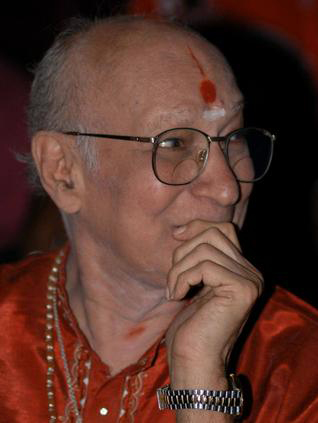
Raghunath Panigrahi.
The news of the passing away of the renowned Hindustani classical musician Raghunath Panigrahi on August 25 brought to mind memories of my and my brother Lakshmipathi’s brief friendship with him some sixty odd years ago. We were respectively in our late teens and early twenties then, and residents of Pelathope Street in Mylapore. Raghunath was in a lodge at the junction of our street and Ramakrishna Math Road. There used to be a hotel named Amarjyoti Cafe operating from a two-storied building at the junction. It was essentially an Udupi style vegetarian restaurant; but it also provided a very basic dormitory type of accommodattion for bachelors in rooms on the first floor at, what I presumed, must have been very cheap rates. Raghunath, then just out of Kalakshetra and a struggling young musician, had a dormitory bed in the maadi of Amarjyoti Cafe.
There was one celebrity resident in our street in those days, an Andhra stage actor, Kalyanam Raghuramiah, popularly known as ‘Finger Flute Raghuramiah (for his uncanny ability of rendering elaborate raghas to absolute perfection by whistling, with his right forefinger placed inside his mouth). Raghuramiah also had a great singing voice and was famous for his rendering of Telugu padyams, with raga alapanas and sangats infused with stunning bhrigas.
Raghunath Panigrahi was perhaps taking music lessons from Raghuramiah at that time. I am not sure of that because we never got to talking about it at any time. But he would go to Raghuramiah’s house regularly in the evenings and spend an hour or so there. I am sure of that because he had to pass opposite our house to get to Raghuramiah’s house and we watched him almost every day. It was not long before we started exchanging smiles and then became friends.
A very popular pastime of us Chennaiites in those days was to stand in street corners and indulge in endless chats. It was more popular as an after-dinner pastime, and every neighbourhood had its own chat groups that would gather every evening after dinner for a half-hour or so of friendly and sometimes not so friendly banter at the street corner. Soon Raghunath, Lakshmipathi and I formed a chat group. Raghunath would come down to the street from his maadi and we would stand in our street junction and chat. Raghunath was fluent in English, and spoke quite a bit of Telugu and Tamil.
We mostly discussed Tamil music. Lakshmipathi was more into music than me – he was a decent singer himself – and was a great admirer of Ghantasala Venkateswara Rao. Raghunath thought very highly of A.M. Raja. We would have endless discussions about our favourite songs. Raghunath could do an excellent imitation of both Ghantasala and Raja. He would surprise us with his version of how he thought Raja would have rendered a song sung originally by Ghantasala. We became his great admirers.
In those days in Madras in general, and in Mylapore in particular, we hardly came across people from outside the four southern states, Tamils, Telugus, Kannadigas and Malayalis. And many of our friends were named Subramanian, Srinivasan or Venkataraman. So a young man with a different name, and with a surname, fascinated us. We could not believe that ‘Panigrahi’ could be a part of the name of a person. Lakshmipathi who has always had an impish nature in him (later in life as Dr. Lakshmipathi he has written three best-sellers on medical humour) asked Raghunath about it. In Sanskritised Tamil the term panigrahanam (literally meaning holding of the hand) means Lakshmipathi once joked with Raghunath about it.
“When is the panigrahanam of Panigrahi to be?” he asked.
“Very soon! Very soon, I hope,” replied Raghunath, only half-smiling.
Now, viewing things in retrospect, I am pretty sure that thoughts of his friend Sanjukta from Kalakshetra must have crossed his mind at that moment.
Of course, as the art world knows all too well, that panigrahanam did take place.
The rest, as they say, is history.
|

